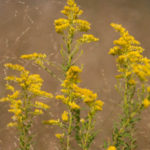Vol. 21 Issue 3, Fall 2016
By Ann Garvey, Audubon at Home Ambassador
It is very common to hear people remark on not having Goldenrod (Solidago spp.) in their gardens because they cause allergies. Goldenrod is a wonderful plant to have in your fall garden to help Monarchs build up their fat supply for the long journey to Mexico. It also supports numerous bees as well as other butterflies. Ragweed (Ambrosia artemisiifolia) is the plant that causes many people to have allergy symptoms.
There are numerous important differences between the two species as summarized in the chart below. In particular, note that ragweed does not support pollinators and its pollen is small grained and carried on the wind. Some of the goldenrods in our area that produce nectar in late summer and into the fall include:
Blue-stemmed or Wreath Goldenrod (Solidago caesia) – does best in full to partial sun. Indigo Buntings are among the birds that enjoy its seeds.
Zig Zag Goldenrod (Solidago fexicalus) – does well in partial sun and feeds many types of insects.
Grey Goldenrod (Solidago nemoralis) – blooms later in the fall, frequently into November. Spreads by rhizomes and adapts to challenging areas where it is difficult to grow other plants.


| Ragweed | Goldenrod | |
| Flower | Tiny green to yellow | Bright yellow, large clusters |
| Pollinated | Wind pollinated – flowers lack nectar | Pollinators attracted to nectar |
| Pollen | Small-grained pollen | Large-grained pollen |
| Leaves | Smooth, deep lobed | Smooth, no lobes |
| Stems | Purple, hairy and branched | Thick, green and un-branched – hairy or smooth |
| Plant type | Annual | Perennial |

